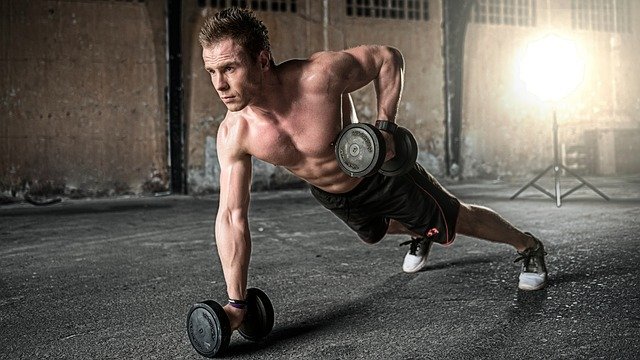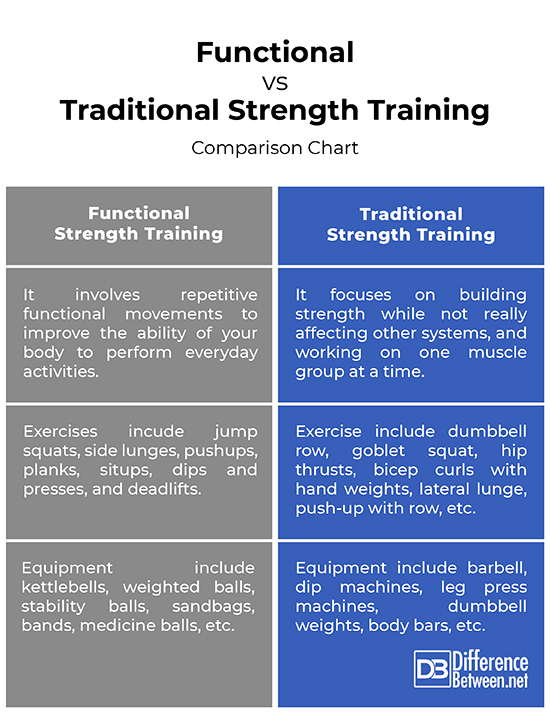Difference Between Functional and Traditional Strength Training
The training and conditional methods have evolved dramatically over the last few decades. World records have fallen, rehabilitation times have been marginally decreased, and today, even the athletes in their 40s are competing in professional sports, which was once the domain for the younger athletes. The stamina and energy we see in the field these days are truly amazing. Nutrition and skill training have played a huge role in this transformation we are seeing on the playing field. The growing popularity of functional training is a sign that something has changed.

What is Functional Strength Training?
Functional training is probably one of the most popular training philosophies to evolve over the years. Although, a specific definition is yet to be widely accepted, functional training, as the name suggests, develops functional strength specific to the activities performed in daily life. It improves the ability of your body to perform everyday activities, from carrying grocery bags to your kitchen to moving up and down the stairs. Functional training simply makes you feel better, making you more active, stronger and tougher. It involves exercises that train your muscles to work together by incorporating common movements you use at work or home and in your daily activities. It involves full body movements and it’s the most important strength to develop for sports that are not related to weightlifting. Functional training is about movement, not equipment.

What is Traditional Strength Training?
Traditional strength training focuses on building strength while not really affecting other systems. It works on one muscle group at a time to exhaustion using heavy weights or the fancy machines you see at the gym. Traditional strength training encompasses the prescription of conventional gym-based training exercises such as bench press, triceps extensions, latissimus pull-downs, pull ups, and squats. It basically uses resistance training principles and is also used to bulk up your muscles. It isolates a specific group of muscles and involves lifting weights to gain muscle strength. The techniques used in this type of strength training are very similar to many other types of workouts. A lot of traditional strength training requires workouts using the commonly used gym equipment such as barbell, dip machines, leg press machines, dumbbell weights, and so on.
Difference between Functional and Traditional Strength Training
Definition
Functional training is about movement, not equipment. The term is used to describe any type of training that is no bodybuilding. It works to train different parts of your body on their functional movements in that they improve your health and ability to perform day-to-day activities. Traditional strength training, on the other hand, focuses on building strength while not really affecting other systems and is also used to bulk up muscles. It works by isolating individual muscles to gain muscle strength.
Exercise
Functional training is about movement and developing core muscles and muscle/movement balance. It involves exercises that train your muscles to work together by incorporating common movements you use at work or home and in your daily activities, such as jump squats, side lunges, pushups, planks, situps, dips and presses, and deadlifts. Traditional strength training involves exercises that use resistance training principles, such as dumbbell row, goblet squat, hip thrusts, bicep curls with hand weights, lateral lunge, push-up with row, and so on.
Equipment
The equipment used for functional training is more extensive and include kettlebells, weighted balls, stability balls, sandbags, bands, medicine balls, water-based equipment, freeform boards, or a combination of each. A lot of traditional strength training requires workouts using the commonly used gym equipment such as barbell, dip machines, leg press machines, dumbbell weights, body bars, resistance bands, and so on.
Functional vs. Traditional Strength Training: Comparison Chart

Summary
Functional strength training involves exercises that train your muscles to work together by incorporating common movements you use at work or home and in your daily activities. It’s the most important strength to develop for sports that are not related to weightlifting. However, functional training can be a bit challenging to train and monitor. It is more popular in the sport world and aims at developing functional strength. Traditional strength training is about building strength while working on a specific muscle group and not affecting other systems.
What are 3 different types of strength exercises?
The three basic strength training exercises are lunges, squats and step-ups.
What is considered functional strength training?
Functional strength training is about movement, not equipment. It involves full body movements and it’s the most important strength to develop for sports that are not related to weightlifting.
What’s the difference between cross training and functional training?
Functional training is about providing overall strength and balance and the many exercise involve training your whole body and muscles you use almost every day. Cross training involves a combination of workouts based on functional movements performed at high intensity.
What are examples of traditional strength training?
Traditional strength training exercises use resistance training principles, focusing on isolated body parts, bicep curl, bench press, shoulder press, to build strength and bulk in a specific muscle group.
Can functional training build muscle?
Functional training works on core strength and stability and involves multiple muscles.
- Difference Between Caucus and Primary - June 18, 2024
- Difference Between PPO and POS - May 30, 2024
- Difference Between RFID and NFC - May 28, 2024
Search DifferenceBetween.net :
Leave a Response
References :
[0]Santana, Juan Carlos. Functional Training. Illinois, United States: Human Kinetics, 2015. Print
[1]Bruscia, Guido. The Functional Training Bible. Aachen, Germany: Meyer & Meyer Sport, 2015. Print
[2]Miller, Ingrid Loos and Jim Herkimer. Functional Strength for Triathletes: Exercises for Top Performance. Aachen, Germany: Meyer & Meyer Sport, 2012. Print
[3]Schumann, Moritz and Bent R. Rønnestad. Concurrent Aerobic and Strength Training: Scientific Basics and Practical Applications. Berlin, Germany: Springer, 2018. Print
[4]Image credit: https://pixabay.com/photos/woman-fitness-workout-muscles-fit-4618189/
[5]Image credit: https://pixabay.com/photos/man-exercise-fitness-gym-dumbbells-2604149/
